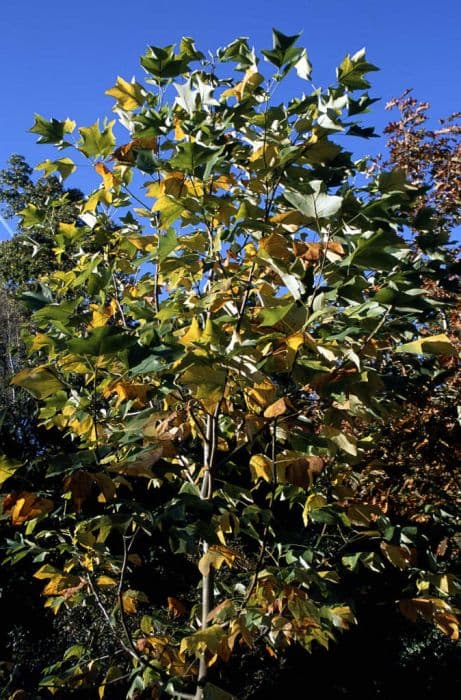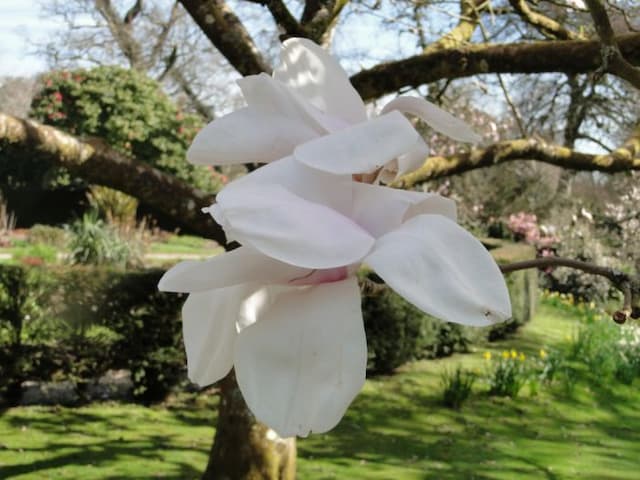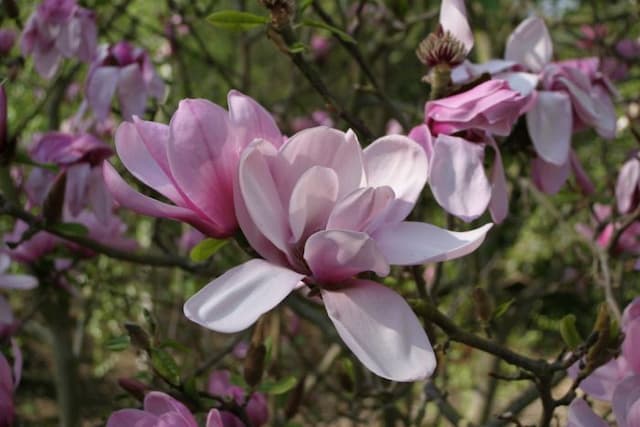Elizabeth Magnolia Magnolia 'Elizabeth'

ABOUT
Magnolia 'Elizabeth' is a captivating plant renowned for its striking floral display. This plant features an abundance of large, cup-shaped flowers. The blooms are a distinguished pale yellow, transitioning to ivory white, providing a soft yet splendid color palette in the spring season. Each flower is composed of numerous velvety petals that elegantly unfurl as they mature, revealing a creamy interior that contrasts beautifully with the outer hues. The leaves of Magnolia 'Elizabeth' are also noteworthy with their glossy, rich green color. They offer a lush backdrop to the luminous flowers, creating a refreshing visual harmony. These leaves are broad with a smooth texture, often appearing somewhat leathery to the touch. Overall, the appearance of Magnolia 'Elizabeth' is one of serene beauty, with its delicate yellow flowers and vibrant green foliage captivating the senses and adding a touch of elegance to any garden where it is grown.
About this plant
 Names
NamesSynonyms
Elizabeth Magnolia, Yellow Magnolia
Common names
Magnolia 'Elizabeth'.
 Toxicity
ToxicityTo humans
Magnolia 'Elizabeth', commonly known as Magnolia, is not considered toxic to humans. There are no known toxic effects from ingesting any part of this plant, and it is generally regarded as safe. However, as with any plant material, individual allergic reactions or sensitivities are possible.
To pets
Magnolia 'Elizabeth', commonly known as Magnolia, is not known to be toxic to pets. This plant is generally considered non-toxic to cats, dogs, and other domestic animals. Ingesting parts of this plant should not result in poisoning or serious health issues, though individual animals may have different levels of sensitivity, and consuming plant material can sometimes cause mild stomach upset due to the fiber content.
 Characteristics
CharacteristicsLife cycle
Perennials
Foliage type
Deciduous
Color of leaves
Green
Flower color
Yellow
Height
20-30 feet (6-9 meters)
Spread
10-15 feet (3-4.5 meters)
Plant type
Tree
Hardiness zones
5
Native area
Southeastern United States
Benefits
 General Benefits
General Benefits- Aesthetic Appeal: Magnolia 'Elizabeth' offers large, showy yellow flowers that are especially striking in the spring and can enhance any landscape with its beauty.
- Shade Provision: When mature, the tree provides shade, creating cool areas and potentially reducing the need for air conditioning in nearby structures.
- Habitat for Wildlife: The tree serves as a habitat for various species of birds and insects, which find food and shelter within its branches.
- Seasonal Interest: Offering year-round interest with its flowers in spring, lush green leaves in summer, and textured bark and seed pods in fall, Magnolia 'Elizabeth' provides visual interest throughout the year.
- Durability: Once established, Magnolia 'Elizabeth' is fairly hardy and can withstand a variety of environmental conditions, making it a long-lasting addition to a garden or landscape.
- Low Maintenance: Requiring minimal pruning and care once established, it is an ideal option for those looking for a low-maintenance tree.
- Pollen Production: Beneficial for local bees and pollinators, the tree produces pollen which supports the ecosystem and can contribute to the health of local gardens.
- Privacy Screen: Dense foliage can serve as an effective visual barrier, making it a natural privacy screen for homes and gardens.
- Canopy Layering: Helps create layered planting designs in larger landscapes, providing structure and height variety.
- Cultural Significance: Often associated with nobility and dignity, magnolias have a strong cultural presence and can add a sense of tradition to a space.
- Sound Absorption: The tree's dense foliage can help absorb sound, reducing noise pollution in a garden or yard.
 Medical Properties
Medical Properties- This plant is not used for medical purposes.
 Air-purifying Qualities
Air-purifying QualitiesThis plant is not specifically known for air purifying qualities.
 Other Uses
Other Uses- Magnolia tea: The leaves and petals of the Magnolia can be dried and used to make a lightly flavored tea.
- Magnolia sachets: Dried Magnolia petals can be placed in sachets to naturally scent drawers and closets.
- Natural fabric dye: The petals and bark of the Magnolia can be used to create a natural greenish-brown dye for fabrics.
- Crafting and decoration: Dried Magnolia petals and leaves can be used in crafting for decorative purposes, such as in wreaths and arrangements.
- Culinary garnish: Fresh Magnolia petals can be used as a delicate garnish for desserts and drinks, adding a floral touch.
- Candle making: The scent of Magnolia flowers can be extracted and used in homemade candles to impart a pleasant fragrance.
- Kokedama: The roots of the Magnolia can be used in the Japanese art form of Kokedama, where plants grow in a moss-covered ball of soil.
- Magnolia petal confetti: Dried petals of the Magnolia can be used as a biodegradable confetti for celebrations and weddings.
- Photography: The Magnolia tree and its flowers can serve as a striking subject or backdrop for outdoor photography.
- Floral baths: Fresh or dried Magnolia petals can be added to bathwater for a luxurious and fragrant bathing experience.
Interesting Facts
 Feng Shui
Feng ShuiThe Magnolia is not used in Feng Shui practice.
 Zodiac Sign Compitability
Zodiac Sign CompitabilityThe Magnolia is not used in astrology practice.
 Plant Symbolism
Plant Symbolism- Nobility: The Magnolia 'Elizabeth' is often associated with nobility due to its dignified and impressive flowers.
- Purity: With its pure white blossoms, the magnolia is symbolic of purity and innocence.
- Dignity: The stately nature of the tree and the durability of its blooms represent dignity and poise.
- Perseverance: As an early spring flower, the magnolia is seen as a symbol of the power to persevere through challenging conditions.
- Feminine Beauty: The delicate appearance and grandeur of the blooms make the magnolia represent feminine beauty and gentleness.
 Water
WaterThe Magnolia 'Elizabeth' should be watered deeply to ensure the root zone is thoroughly moistened; this usually implies using about 1 to 1.5 gallons for smaller plants and up to 5 gallons for larger, established trees. During the growing season, watering should take place once a week, but frequency should increase to twice a week during hot or dry weather. In winter or during periods of rain, reduce the watering to every two weeks or less, as necessary. It's critical not to let the soil dry out completely but also to avoid waterlogging, as this can lead to root rot.
 Light
LightThe Magnolia 'Elizabeth' thrives in full sun to partial shade conditions. The ideal spot allows for morning sunlight with some afternoon shade, or filtered light throughout the day. This exposure ensures the plant gets the light it needs without being harmed by the intense midday or afternoon sun, which could lead to leaf scorch.
 Temperature
TemperatureMagnolia 'Elizabeth' prefers temperate conditions and fares best when the temperature is between 70 to 85 degrees Fahrenheit. It can withstand minimum temperatures down to about 20 degrees Fahrenheit but may suffer damage in colder conditions. The maximum temperature tolerance is approximately 95 degrees Fahrenheit, beyond which the plant may experience stress.
 Pruning
PruningPrune the Magnolia 'Elizabeth' to maintain its shape and remove dead or damaged wood. This is best done after flowering, but before mid-summer, to allow cuts to heal before the colder months. Generally, pruning is needed once a year, and selective removal of branches can encourage air circulation and light penetration, promoting overall plant health.
 Cleaning
CleaningAs needed
 Soil
SoilMagnolia 'Elizabeth', commonly known as Elizabeth Magnolia, thrives in moist, well-drained, acidic soil with a pH of 5.0 to 6.5. A mix that comprises organic matter such as leaf mold or compost, and components like pine bark for drainage is ideal for this magnolia.
 Repotting
RepottingElizabeth Magnolia, a larger shrub or small tree, does not require frequent repotting. It is typically planted directly in the ground. If grown in containers, repotting might be necessary every 3 to 5 years to refresh the soil and manage root growth.
 Humidity & Misting
Humidity & MistingElizabeth Magnolia prefers average to high humidity levels but is quite adaptable to different atmospheric moistures as long as it’s grown in well-draining soil and not subjected to prolonged dry air conditions.
 Suitable locations
Suitable locationsIndoor
Provide large space, bright light, and keep soil moist.
Outdoor
Plant in partial shade, provide mulch, and shelter from winds.
Hardiness zone
4-9 USDA
 Life cycle
Life cycleThe Magnolia 'Elizabeth' begins its life cycle as a seed, which when germinated in favorable conditions of warm temperature and moist soil, develops into a seedling. As the seedling grows, it progresses to the sapling stage, showcasing initial leaves and a developing root system. Over several years, the sapling matures into an adult tree, characterized by a woody trunk and branches, broad green leaves, and the capacity to flower. Each spring, the adult Magnolia 'Elizabeth' produces distinctive yellow flowers before the leaves fully expand, which are pollinated by insects, leading to the development of cone-like fruit that releases seeds when mature. In a natural setting, the seeds would be dispersed by wind or wildlife, potentially giving rise to new plants. The adult tree can live for several decades, going through repeated seasonal cycles of flowering and dormancy.
 Propogation
PropogationPropogation time
Spring to Summer
The Magnolia 'Elizabeth', known for its beautiful yellow flowers, is commonly propagated by semi-hardwood cuttings taken in late summer. This method involves selecting healthy, current year's growth that has begun to mature but is not fully hardened. A cutting, typically 4 to 6 inches (10 to 15 centimeters) long, is made just below a leaf node, and the leaves on the lower half are removed. The base of the cutting is then treated with rooting hormone to encourage root development and planted in a mixture of peat and perlite to provide optimal rooting conditions. The cutting should be kept in a humid environment, with indirect light and consistent moisture, until roots have developed, which typically takes several weeks. Once established, the young plant can be gradually acclimated to outdoor conditions and eventually planted out in the garden.








![Magnolia [Felix Jury]](/_next/image?url=https%3A%2F%2Fplants-admin.emdemapps.com%2Fimages%2Fplants%2F%2Fimages%2F604b61a0b23b7.png&w=640&q=75)
